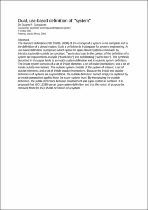JavaScript is disabled for your browser. Some features of this site may not work without it.
- ResearchSpace
- →
- Research Publications/Outputs
- →
- Conference Publications
- →
- View Item
| dc.contributor.author |
Gonçalves, DP

|
|
| dc.date.accessioned | 2016-10-13T13:57:57Z | |
| dc.date.available | 2016-10-13T13:57:57Z | |
| dc.date.issued | 2015-09 | |
| dc.identifier.citation | Gonçalves, D.P. 2015. Dual, use-based definition of "system". In: 11th INCOSE SA Conference 2015 "Systems Engineering - Shifting the barriers", 16-18 September 2015, CSIR International Convention Centre | en_US |
| dc.identifier.uri | http://www.incose.org.za/pubs/2015/Papers/SA_INCOSE_2015_submission_2.pdf | |
| dc.identifier.uri | http://hdl.handle.net/10204/8843 | |
| dc.description | 11th INCOSE SA Conference 2015 "Systems Engineering - Shifting the barriers", CSIR International Convention Centre, 16-18 September 2015. Due to copyright restrictions, the attached PDF file only contains the abstract of the full text item. For access to the full text item, please consult the publisher's website | en_US |
| dc.description.abstract | The standard definition (ISO 15288, 2008) of the concept of a system is not complete and is the definition of a closed system. Such a definition is inadequate for systems engineering. A use-based definition is proposed which spans the open-closed systems continuum by introducing inside-outside perspectives. Two typical uses in the context of the definition of a system are requirements analysis ("black box") and architecting ("white box"). The synthesis described in the paper leads to an inside system definition and an outside system definition. The inside system consists of a set of inside elements; a set of inside interactions; and a set of inside-outside interactions. The outside system consists of the system of interest; a set of outside elements; and a set of inside-outside interactions. Because the inside and outside definitions of systems are asymmetrical, the outside definition cannot simply be replaced by an inside perspective applied from the super-system level. By introducing the outside definition, the subtle difference between environment and super-system is surfaced. It is proposed that ISO 15288 use an open system definition and that the notion of purpose be removed from the ISO 15288 definition of a system. | en_US |
| dc.language.iso | en | en_US |
| dc.publisher | International Council on Systems Engineering South Africa | en_US |
| dc.relation.ispartofseries | Worklist;15618 | |
| dc.subject | Systems engineering | en_US |
| dc.subject | Requirements analysis | en_US |
| dc.subject | Architecting | en_US |
| dc.subject | 11th INCOSE SA Conference 2015 "Systems Engineering - Shifting the barriers | en_US |
| dc.title | Dual, use-based definition of "system" | en_US |
| dc.type | Conference Presentation | en_US |
| dc.identifier.apacitation | Gonçalves, D. (2015). Dual, use-based definition of "system". International Council on Systems Engineering South Africa. http://hdl.handle.net/10204/8843 | en_ZA |
| dc.identifier.chicagocitation | Gonçalves, DP. "Dual, use-based definition of "system"." (2015): http://hdl.handle.net/10204/8843 | en_ZA |
| dc.identifier.vancouvercitation | Gonçalves D, Dual, use-based definition of "system"; International Council on Systems Engineering South Africa; 2015. http://hdl.handle.net/10204/8843 . | en_ZA |
| dc.identifier.ris | TY - Conference Presentation AU - Gonçalves, DP AB - The standard definition (ISO 15288, 2008) of the concept of a system is not complete and is the definition of a closed system. Such a definition is inadequate for systems engineering. A use-based definition is proposed which spans the open-closed systems continuum by introducing inside-outside perspectives. Two typical uses in the context of the definition of a system are requirements analysis ("black box") and architecting ("white box"). The synthesis described in the paper leads to an inside system definition and an outside system definition. The inside system consists of a set of inside elements; a set of inside interactions; and a set of inside-outside interactions. The outside system consists of the system of interest; a set of outside elements; and a set of inside-outside interactions. Because the inside and outside definitions of systems are asymmetrical, the outside definition cannot simply be replaced by an inside perspective applied from the super-system level. By introducing the outside definition, the subtle difference between environment and super-system is surfaced. It is proposed that ISO 15288 use an open system definition and that the notion of purpose be removed from the ISO 15288 definition of a system. DA - 2015-09 DB - ResearchSpace DP - CSIR KW - Systems engineering KW - Requirements analysis KW - Architecting KW - 11th INCOSE SA Conference 2015 "Systems Engineering - Shifting the barriers LK - https://researchspace.csir.co.za PY - 2015 T1 - Dual, use-based definition of "system" TI - Dual, use-based definition of "system" UR - http://hdl.handle.net/10204/8843 ER - | en_ZA |






